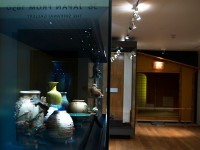Room 36 | Japan from 1850 gallery
Explore the major technical and creative developments in arts and crafts of Japan after 1850 and visit the Ashmolean's tea house.

Galleries : 29 objects
Show search help- Reference URL
Actions
Vase with dragon amid waves
-
Details
- Associated place
- Date
- c. 1905
- Artist/maker
-
Kumeno Teitaro (1865 - 1939)
- Material and technique
- gold, with cloisonné enamel; metal collar, probably shakudō
- Dimensions
-
21.6 cm (height)
4 cm (diameter)
- Material index
-
processed material › metal › gold,processed material › metal › alloy › copper alloy › shakudō
- Technique index
- Object type index
- No. of items
- 1
- Credit line
- Purchased with the assistance of the Story Fund, 1999.
- Accession no.
- EA1999.104
-
Further reading
Impey, Oliver, and Joyce Seaman, Japanese Decorative Arts of the Meiji Period 1868-1912, Ashmolean Handbooks (Oxford: Ashmolean Museum, 2005), no. 41 on p. 86, p. 8, illus. pp. 86-87
Glossary (2)
cloisonné, shakudō
-
cloisonné
Decorative technique in which wires are attached to a metal body and coloured enamels are applied between the wires.
-
shakudō
alloy of copper and gold, patinated to a dark blue-black colour
Location
Objects are sometimes moved to a different location. Our object location data is usually updated on a monthly basis. Contact the Jameel Study Centre if you are planning to visit the museum to see a particular object on display, or would like to arrange an appointment to see an object in our reserve collections.
Collection trails
Galleries
Publications online
-

Japanese Decorative Arts of the Meiji Period
Tall, slender vase with trumpet mouth. A gold dragon amid swirling waves encircles the body of green and pink enamels. A collar around the base of the neck incorporates the pearl, chased by the dragon. Stamped seal; Kume.
A tour de force of the later cloisonné techniques, this sculptural vase in gold and graded colour enamels has a pair now in a private collection. This is almost a culmination point in the making of cloisonné, it could hardly get further from its origins than this. Unusually, this vase was made in two pieces, with a collar around the neck as a join.
Notice
Objects may have since been removed or replaced from a gallery. Click into an individual object record to confirm whether or not an object is currently on display. Our object location data is usually updated on a monthly basis, so contact the Jameel Study Centre if you are planning to visit the museum to see a particular Eastern Art object.
© 2013 University of Oxford - Ashmolean Museum












